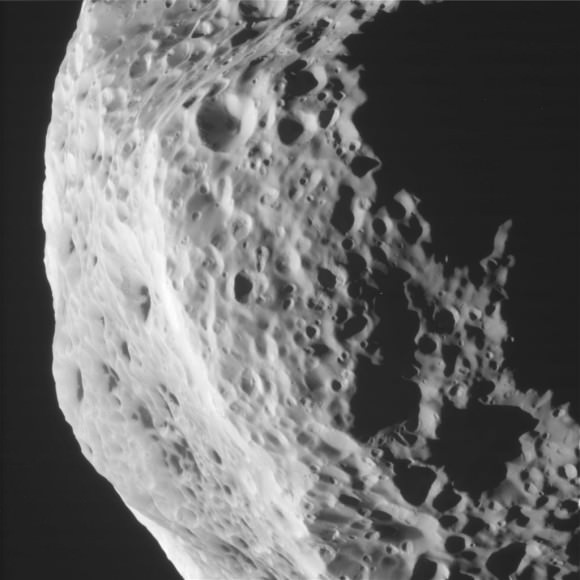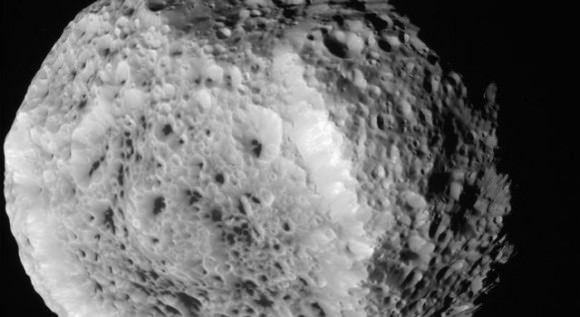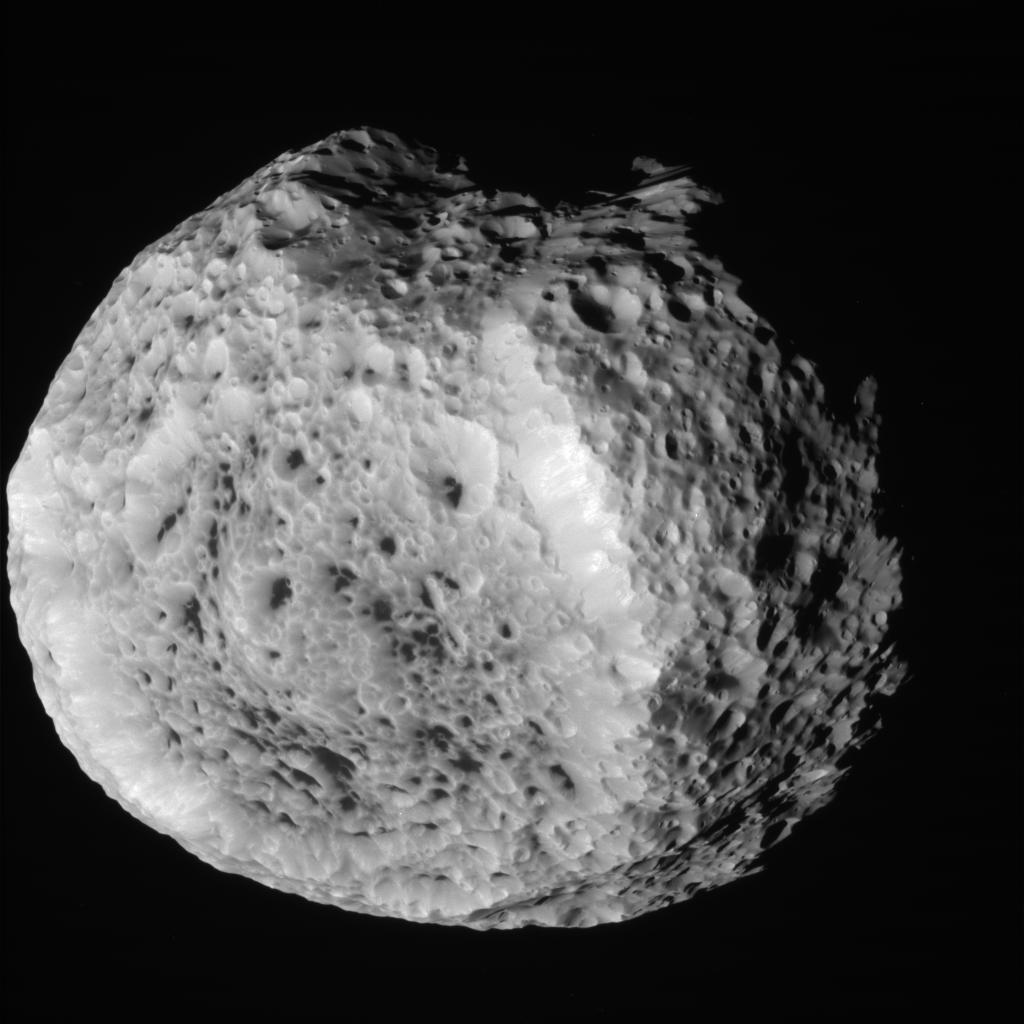[/caption]
It might be one of the weirdest-looking moons in the solar system: Saturn’s moon Hyperion looks like a giant sponge. Additionally, its eccentric orbit makes it subject to gravitational forces from Saturn, so it is just tumbling along, almost out of control. Just yesterday, August 25, 2011, the Cassini spacecraft made a relatively close flyby of Hyperion (24,000 km 15,000 miles away) and took some amazing images.
“Hyperion is a small moon … just 168 miles across (270 kilometers)… orbiting between Titan and Iapetus,” said Carolyn Porco in an email. Porco is the Cassini imaging team lead. “It has an irregular shape and surface appearance, and it rotates chaotically as it tumbles along in orbit, making it impossible to say just exactly what terrain we would image during this flyby.”
See some more of the shots below:

Scientists say this flyby’s closeness has likely allowed Cassini’s cameras to map new territory. At the very least, it will help scientists improve color measurements of the moon. It will also help them determine how the moon’s brightness changes as lighting and viewing conditions change, which can provide insight into the texture of the surface. The color measurements provide additional information about different materials on the moon’s deeply pitted surface.


The next closest pass of Hyperion is coming up again soon: Sept. 16, 2011, when it passes the tumbling moon at a distance of about 36,000 miles (58,000 kilometers).
See more raw images at the CICLOPS website.


I can’t really explain why (perhaps the ‘softness’ of the features), but it looks like it is composed mainly of ices to me, like the nucleus of some huge captured ancient comet.
I can’t really explain why (perhaps the ‘softness’ of the features), but it looks like it is composed mainly of ices to me, like the nucleus of some huge captured ancient comet.
It also looks like a ball of sand !, and as you describe the soft appearance, makes it look like a batch of “BB’s shot into a sand patch !
Possible keys to its strange appearance may lie buried in a few significant facts: This possible “remnant of a larger moon” is “the largest known irregular … body in the solar system.” ….” its eccentric orbit makes it subject to gravitational forces from Saturn, so it is just tumbling along, almost out of control.”–NA
“Hyperion orbits at a mean distance of 1,481,100 km (920,300 miles) from Saturn in an eccentric orbit. This contributes to variations in the spin or rotation of Hyperion. A stronger effect on Hyperion’s rotation is that it is in resonance with Saturn’s largest moon, Titan, which orbits at 1,221,850 km (759,200 miles). Thus, the two objects speed up and slow down as they pass each other in a complex set of variations. Because Hyperion is much smaller than Titan, its rotation and orbit are affected vastly more than the larger moon, and Titan apparently keeps the Hyperion orbit eccentric rather than growing more circular over time.”
Couple that variability in tidal influences with its high ice content, and possible porous composition, and explanations may rise to the surface.
“Hyperion craters are particularly deep and do not have significant rays of ejecta (although there appears to have been slumping or landslides inside many of the bigger craters). The result is a curiously punched-in look, somewhat like the surface of a sponge or a wasp nest. Planetary geologists have theorized that Hyperion’s high-porosity and low density would crater more by compression than excavation. Many of the crater walls on Hyperion are bright, which suggests an abundance of water ice.”
“Hyperion’s density is slightly more than half that of water. This could be due to water ice with gaps (porosity) of more than 40 percent. Also, lighter materials, such as frozen methane or carbon dioxide, could make up part of Hyperion. This is consistent with the concept of Hyperion accrediting from a number of smaller ice and rock bodies, but not having enough gravity to compact them. Thus, Hyperion might be similar to a large rubble pile.”
It just really struck me, the robotic marvel that is the Cassini spacecraft may, indeed, be examining, in marvelous close-up detail, an inactive, cometary remnant ( Rob Hemmings post ). Other so called “moons” may also be harbored members of those spacefaring voyagers.
[ Most quotes from Nasa’s Solar System Exploration website: http://solarsystem.nasa.gov/planets/profile.cfm?Object=Hyperion
Possible keys to its strange appearance may lie buried in a few significant facts: This possible “remnant of a larger moon” is “the largest known irregular … body in the solar system.” ….” its eccentric orbit makes it subject to gravitational forces from Saturn, so it is just tumbling along, almost out of control.”–NA
“Hyperion orbits at a mean distance of 1,481,100 km (920,300 miles) from Saturn in an eccentric orbit. This contributes to variations in the spin or rotation of Hyperion. A stronger effect on Hyperion’s rotation is that it is in resonance with Saturn’s largest moon, Titan, which orbits at 1,221,850 km (759,200 miles). Thus, the two objects speed up and slow down as they pass each other in a complex set of variations. Because Hyperion is much smaller than Titan, its rotation and orbit are affected vastly more than the larger moon, and Titan apparently keeps the Hyperion orbit eccentric rather than growing more circular over time.”
Couple that variability in tidal influences with its high ice content, and possible porous composition, and explanations may rise to the surface.
“Hyperion craters are particularly deep and do not have significant rays of ejecta (although there appears to have been slumping or landslides inside many of the bigger craters). The result is a curiously punched-in look, somewhat like the surface of a sponge or a wasp nest. Planetary geologists have theorized that Hyperion’s high-porosity and low density would crater more by compression than excavation. Many of the crater walls on Hyperion are bright, which suggests an abundance of water ice.”
“Hyperion’s density is slightly more than half that of water. This could be due to water ice with gaps (porosity) of more than 40 percent. Also, lighter materials, such as frozen methane or carbon dioxide, could make up part of Hyperion. This is consistent with the concept of Hyperion accrediting from a number of smaller ice and rock bodies, but not having enough gravity to compact them. Thus, Hyperion might be similar to a large rubble pile.”
It just really struck me, the robotic marvel that is the Cassini spacecraft may, indeed, be examining, in marvelous close-up detail, an inactive, cometary remnant ( Rob Hemmings post ). Other so called “moons” may also be harbored members of those spacefaring voyagers.
[ Most quotes from Nasa’s Solar System Exploration website: http://solarsystem.nasa.gov/planets/profile.cfm?Object=Hyperion
It looks like it’s been through the Late, Middle and Early(??) bombardment of the Solar System. Definitely a battered body.